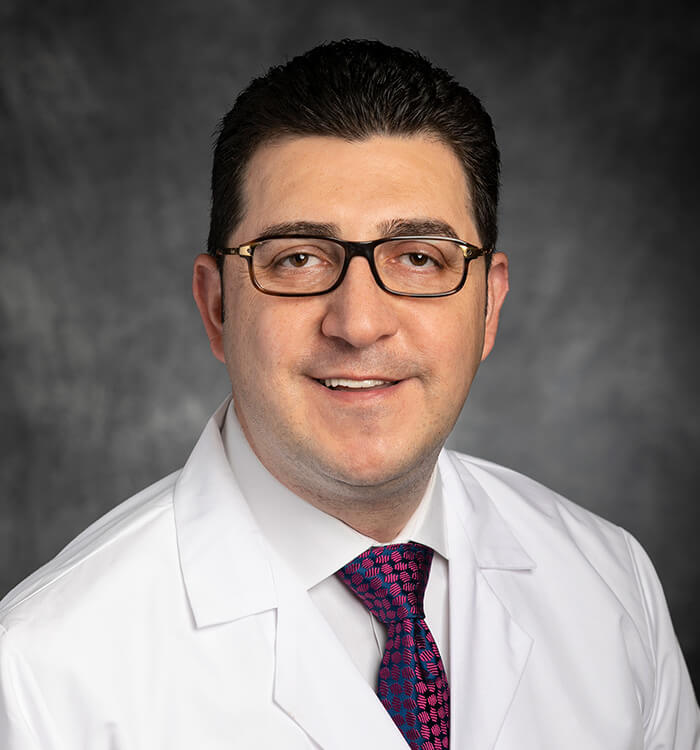International Study Finds Thrombectomy Highly Effective Long-Term Treatment For Large Strokes
June 18, 2024
Innovations in Neurology & Neurosurgery | Summer 2024
One year ago, University Hospitals Cleveland Medical Center launched the watershed international SELECT2 trial that established the efficacy of endovascular thrombectomy (EVT) in patients experiencing large ischemic stroke who were previously thought too risky for the intervention. Long-term follow-up has found that patients treated with EVT plus medical management (MM) experienced dramatically better recovery than patients who received MM alone.
 Amrou Sarraj, MD
Amrou Sarraj, MDUniversity Hospitals served as the coordinating center for 31 hospitals in North America, Europe, Australia and New Zealand. Initial outcomes of the SELECT2 trial were published last year in the New England Journal of Medicine. Since then, researchers have continued to follow patients and analyze data.
“Our findings at one year have been transformational because they illustrate that not only was the effect of EVT treatment maintained but also patients continued to improve,” says Amrou Sarraj, MD, Director of the Cerebrovascular Center and Comprehensive Stroke Center at University Hospitals and the Global Principal Investigator and Lead Author of the trial. “Stroke sits with patients and their families and becomes a lifestyle, so establishing that quality of life improved is very impactful.”
Dr. Sarraj and his co-investigators recently published the culmination of SELECT2 findings in JAMA, JAMA Neurology and The Lancet. They determined that patients given EVT plus MM exhibited higher rates of cognition and functionality, lower rates of depression and improved social scores when compared to those who did not receive EVT. Furthermore, one in five patients demonstrated improvement in their functional status from 90-day follow-up.
“What this illustrates is that stroke patients can continue their recovery beyond 90 days,” says Dr. Sarraj, who also is the Director of Stroke Systems and the George M. Humphrey II Chair in Neurology at University Hospitals Neurological Institute.
Previous stroke research rarely gathered outcomes for a full year past the initial cerebrovascular injury, he notes. “We should offer supportive services and rehabilitation beyond the standardly accepted 90-day window to optimize patients’ clinical outcomes.”
Global Impact
The SELECT2 findings are changing protocols worldwide.
“No matter what modality is used to measure the stroke’s core or how large the core is, thrombectomy is safe and efficacious, improves outcomes at 90 days, and continues to deliver benefits at one year,” Dr. Sarraj says. “That doesn’t mean that outcomes in patients with extremely large core strokes were similar to those with smaller strokes.”
He explains that as core size increased, rates of functional and ambulatory independence decreased. However, data showed that patients receiving MM without EVT faired much worse, so the net benefit was maintained.
Analyzing Transfer Data
Throughout the U.S., most patients experiencing symptoms of stroke present to hospitals that are not currently equipped to offer thrombectomy and require transport to an EVT-capable center.
In the JAMA Neurology article published in February 2024, the SELECT2 researchers outlined their findings comparing the efficacy of EVT in directly presenting versus transferred patients experiencing large ischemic strokes.
“Two-thirds of patients required transfer to a tertiary hospital to receive EVT,” Dr. Sarraj says. “Thrombectomy benefit was maintained in those who were transferred. However, prolonged transfer times and evolving ischemic changes were associated with less-favorable EVT outcomes, highlighting the need for rapid triage of stroke patients and optimization of transfer protocols at hospitals throughout the country and abroad.”
Next Steps
“For a long time, two major hurdles have blocked patients from stroke intervention—stroke size and time. Stroke size hurdle has now fallen,” Dr. Sarraj says. “We have had a limit of 24 hours to perform thrombectomy, and we want to extend that window.”
A retrospective cohort international study showed potential benefit of EVT beyond the current 24-hour parameter.
Dr. Sarraj and his colleagues are designing a global, randomized trial coordinated by University Hospitals to enroll patients 24 to 72 hours past stroke presentation.
“We hypothesize that the benefit of EVT treatment will be substantiated, enabling us to help more people,” he says. “We continue to study and push the boundaries of stroke protocols because our goal is to deliver the highest level of care to our patients.”
For more information, contact Dr. Sarraj at 800-552-8338.
Contributing Expert:
Amrou Sarraj, MD
Director, Stroke Systems
University Hospitals Neurological Institute
Director, Cerebrovascular Center and Comprehensive Stroke Center
George M Humphrey II Endowed Chair of Neurology
University Hospitals Cleveland Medical Center
Professor of Neurology
Case Western Reserve University School of Medicine


